Sediment-Deficit Sink-Zone Morphodynamics in Oceanic Island Dune Systems: Integration of Field Data and Remote Sources in the Macaronesian Region
Highlights
- The sink area of dune systems on oceanic islands, such as those in Macaronesia, reflects the sediment deficit inherited from actions carried out throughout the systems.
- The integration of field data and remote sources has facilitated the identification of erosional trends across diverse spatiotemporal scales.
- Management and protection measures aimed at addressing sediment deficits in sink areas of dune systems must consider the entire system to ensure the efficacy of the approach.
- The methodology can be replicated for the identification of erosional trends in sink areas of other oceanic island dune systems.
Abstract
1. Introduction
2. Study Area
2.1. Costa Fragata-Ponta Preta (Sal)—Cabo Verde
2.2. Maspalomas (Gran Canaria)—Canary Islands
2.3. Jandía (Fuerteventura)—Canary Islands
2.4. La Graciosa—Canary Islands
3. Methodology
3.1. Long-Medium Term
3.1.1. Shoreline Identification and DSAS Analysis
3.1.2. Morphological Evolution
3.2. Medium-Short Term
3.2.1. Altimetric Models
3.2.2. Collection of Wind Data
3.2.3. Collection of Sediment Samples and Laboratory Analysis
4. Results and Discussion
4.1. Long-Medium Term
4.1.1. Shoreline Variation and Morphological Evolution
Costa Fragata-Ponta Preta (Sal)—Cabo Verde
Maspalomas (Gran Canaria)—Canary Islands
Jandía (Fuerteventura)—Canary Islands
La Graciosa—Canary Islands
4.2. Medium-Short Term. Sink Zone of La Graciosa Dune System
4.2.1. Topographical Evolution
4.2.2. Wind Flow Dynamics
4.2.3. Sedimentological Characterization
5. General Discussion
Limitations and Data Uncertainty
6. Conclusions
Author Contributions
Funding
Data Availability Statement
Acknowledgments
Conflicts of Interest
References
- Calkoen, F.; Luijendijk, A.; Rivero, C.R.; Kras, E.; Baart, F. Traditional vs. Machine-Learning Methods for Forecasting Sandy Shoreline Evolution Using Historic Satellite-Derived Shorelines. Remote Sens. 2021, 13, 934. [Google Scholar] [CrossRef]
- Lämmle, L.; Perez Filho, A.; Donadio, C.; Arienzo, M.; Ferrara, L.; Santos Cde, J.; Souza, A.O. Anthropogenic Pressure on Hydrographic Basin and Coastal Erosion in the Delta of Paraíba do Sul River, Southeast Brazil. J. Mar. Sci. Eng. 2022, 10, 1585. [Google Scholar] [CrossRef]
- Foti, G.; Barbaro, G.; Barillà, G.C.; Mancuso, P.; Puntorieri, P. Shoreline erosion due to anthropogenic pressure in Calabria (Italy). Eur. J. Remote Sens. 2023, 56, 2140076. [Google Scholar] [CrossRef]
- Hesp, P. Foredunes and blowouts: Initiation, geomorphology and dynamics. Geomorphology 2002, 48, 245–268. [Google Scholar] [CrossRef]
- Martínez, M.L.; Psuty, N.P.; Lubke, R.A. A perspective on coastal dunes. In Coastal Dunes: Ecology and Conservation; Springer: Berlin/Heidelberg, Germany, 2004; pp. 3–10. [Google Scholar]
- Houser, C.; Hamilton, S. Sensitivity of post-hurricane beach and dune recovery to event frequency. Earth Surf. Process. Landf. 2009, 34, 613–628. [Google Scholar] [CrossRef]
- Psuty, N.P.; Silveira, T.M. Global climate change: An opportunity for coastal dunes? J. Coast. Conserv. 2010, 14, 153–160. [Google Scholar] [CrossRef]
- Intergovernmental Panel on Climate Change. Climate change 2023: Synthesis report. In Contribution of Working Groups I, II and III to the Sixth Assessment Report of the Intergovernmental Panel on Climate Change; Core Writing Team, Lee, H., Romero, J., Eds.; IPCC: Geneva, Switzerland, 2023; pp. 35–115. [Google Scholar] [CrossRef]
- Gracia, A.; Rangel-Buitrago, N.; Oakley, J.A.; Williams, A.T. Use of ecosystems in coastal erosion management. Ocean Coast. Manag. 2018, 156, 277–289. [Google Scholar] [CrossRef]
- Islam, M.S.; Crawford, T.W.; Shao, Y. Evaluation of predicted loss of different land use and land cover (LULC) due to coastal erosion in Bangladesh. Front. Environ. Sci. 2023, 11, 1144686. [Google Scholar] [CrossRef]
- Lansu, E.M.; Reijers, V.C.; Höfer, S.; Luijendijk, A.; Rietkerk, M.; Wassen, M.J.; Lammerts, E.J.; van der Heide, T. A global analysis of how human infrastructure squeezes sandy coasts. Nat. Commun. 2024, 15, 432. [Google Scholar] [CrossRef]
- Ranasinghe, R. Assessing climate change impacts on open sandy coasts: A review. Earth-Sci. Rev. 2016, 160, 320–332. [Google Scholar] [CrossRef]
- Bozzeda, F.; Ortega, L.; Costa, L.L.; Fanini, L.; Barboza, C.A.M.; McLachlan, A.; Defeo, O. Global patterns in sandy beach erosion: Unraveling the roles of anthropogenic, climatic and morphodynamic factors. Front. Mar. Sci. 2023, 10, 1270490. [Google Scholar] [CrossRef]
- Cabezas-Rabadán, C.; Pardo-Pascual, J.E.; Palomar-Vazquez, J.; Cooper, A. A remote monitoring approach for coastal engineering projects. Sci. Rep. 2025, 15, 2955. [Google Scholar] [CrossRef]
- Meco, J.; Stearns, C.E. Emergent littoral deposits in the Eastern Canary Islands. Quat. Res. 1981, 15, 199–208. [Google Scholar] [CrossRef]
- Mimura, N.; Nurse, L.; McLean, R.F.; Agard, J.; Briguglio, L.; Lefale, P.; Payet, R.; Sem, G. Small islands. Climate change 2007: Impacts, adaptation and vulnerability. In Contribution of Working Group II to the Fourth Assessment Report of the Intergovernmental Panel on Climate Change; Parry, M.L., Canziani, O.F., Palutikof, J.P., van der Linden, P.J., Hanson, C.D., Eds.; Cambridge University Press: Cambridge, UK, 2007; pp. 687–716. [Google Scholar]
- Roettig, C.B.; Kolb, T.; Zöller, L.; Zech, M.; Faust, D. A detailed chrono-stratigraphical record of canarian dune archives—Interplay of sand supply and volcanism. J. Arid. Environ. 2020, 183, 104240. [Google Scholar] [CrossRef]
- Brooke, B. The distribution of carbonate eolianite. Earth-Sci. Rev. 2001, 55, 135–164. [Google Scholar] [CrossRef]
- Mangas, J.; Pérez-Chacón Espino, E. Composition and provenance of beach sands in La Graciosa, Lanzarote, Fuerteventura and Gran Canaria Islands (eastern Canary Islands, Spain): A review. Environ. Earth Sci. 2023, 82, 102. [Google Scholar] [CrossRef]
- Hernández-Cordero, A.I.; Peña-Alonso, C.; Hernández-Calvento, L.; Ferrer-Valero, N.; Santana-Cordero, A.M.; García-Romero, L.; Pérez-Chacón Espino, E. Aeolian Sedimentary Systems of the Canary Islands. In The Spanish Coastal Systems; Morales, J.A., Ed.; Springer International Publishing: Berlin/Heidelberg, Germany, 2019; pp. 699–725. [Google Scholar] [CrossRef]
- Gao, J.; Kennedy, D.M.; Konlechner, T.M. Coastal dune mobility over the past century: A global review. Prog. Phys. Geogr. 2020, 44, 814–836. [Google Scholar] [CrossRef]
- García-Romero, L.; Hernández-Cordero, A.I.; Fernández-Cabrera, E.; Peña-Alonso, C.; Hernández-Calvento, L.; Pérez-Chacón, E. Urban-touristic impacts on the aeolian sedimentary systems of the Canary Islands: Conflict between development and conservation. Isl. Stud. J. 2016, 11, 91–112. [Google Scholar] [CrossRef]
- Hernández-Calvento, L.; Jackson, D.W.T.; Cooper, A.; Pérez-Chacón, E. Island-Encapsulating Eolian Sedimentary Systems of the Canary and Cape Verde Archipelagos. J. Sediment. Res. 2017, 87, 117–125. [Google Scholar] [CrossRef]
- Gomes, C.; Silva, A.N.; Taborda, R.; Santos, F.; Rebelo, L.; Medina, A. Drivers of island beach evolution: Insights from an island-scale study at Boa Vista (Cabo Verde). Earth Surf. Process. Landf. 2019, 44, 2810–2822. [Google Scholar] [CrossRef]
- Short, A.D.; Jackson, D.W.T. Beach Morphodynamics. In Treatise on Geomorphology; Elsevier Ltd.: Amsterdam, The Netherlands, 2013; Volume 10. [Google Scholar] [CrossRef]
- Fontán-Bouzas, Á.; Alcántara-Carrió, J.; Albarracín, S.; Baptista, P.; Silva, P.A.; Portz, L.; Manzolli, R.P. Multiannual Shore Morphodynamics of a Cuspate Foreland: Maspalomas (Gran Canaria, Canary Islands). J. Mar. Sci. Eng. 2019, 7, 416. [Google Scholar] [CrossRef]
- Pinardo-Barco, S.; Sanromualdo-Collado, A.; García-Romero, L. Can the long-term effects of beach cleaning heavy duty machinery on aeolian sedimentary dynamics be detected by monitoring of vehicle tracks? An applied and methodological approach. J. Environ. Manag. 2023, 325, 116645. [Google Scholar] [CrossRef] [PubMed]
- García-Romero, L.; Hesp, P.A.; Peña-Alonso, C.; da Silva, G.M.; Hernández-Calvento, L. Climate as a control on foredune mode in Southern Australia. Sci. Total Environ. 2019, 694, 133768. [Google Scholar] [CrossRef] [PubMed]
- Hesp, P.A.; Hernández-Calvento, L.; Hernández-Cordero, A.I.; Gallego-Fernández, J.B.; García-Romero, L.; da Silva, G.M.; Ruz, M.-H.; Miot da Silva, G.; Ruz, M.-H. Nebkha development and sediment supply. Sci. Total Environ. 2021, 773, 144815. [Google Scholar] [CrossRef]
- Hesp, P.A.; Hernández-Calvento, L.; Gallego-Fernández, J.B.; Miot da Silva, G.; Hernández-Cordero, A.I.; Ruz, M.-H.; García-Romero, L. Nebkha or not? -Climate control on foredune mode. J. Arid. Environ. 2021, 187, 104444. [Google Scholar] [CrossRef]
- Cabrera-Vega, L.L.; Cruz-Avero, N.; Hernández-Calvento, L.; Hernández-Cordero, A.I.; Fernández-Cabrera, E. Morphological changes in dunes as an indicator of anthropogenic interferences in arid dune fields. J. Coast. Res. 2013, 165, 1271–1276. [Google Scholar] [CrossRef]
- Sanromualdo-Collado, A.; García-Romero, L.; Peña-Alonso, C.; Hernández-Cordero, A.I.; Ferrer-Valero, N.; Hernández-Calvento, L. Spatiotemporal analysis of the impact of artificial beach structures on biogeomorphological processes in an arid beach-dune system. J. Environ. Manag. 2021, 282, 111953. [Google Scholar] [CrossRef]
- Sanromualdo-Collado, A.; García-Romero, L.; Viera-Pérez, M.; Delgado-Fernández, I.; Hernández-Calvento, L. Effects of stone-made wind shelter structures over an arid nebkha foredune. Sci. Total Environ. 2023, 894, 164934. [Google Scholar] [CrossRef]
- García-Romero, L.; Hernández-Cordero, A.I.; Hesp, P.A.; Hernández-Calvento, L.; del Pino, Á.S. Decadal monitoring of Traganum moquinii’s role on foredune morphology of an human impacted arid dunefield. Sci. Total Environ. 2021, 758, 143802. [Google Scholar] [CrossRef]
- Marrero-Rodríguez, N.; García-Romero, L.; Peña-Alonso, C.; Hernández-Cordero, A.I. Biogeomorphological responses of nebkhas to historical long-term land uses in an arid coastal aeolian sedimentary system. Geomorphology 2020, 368, 107348. [Google Scholar] [CrossRef]
- Sanromualdo-Collado, A.; Marrero-Rodríguez, N.; García-Romero, L.; Delgado-Fernández, I.; Viera-Pérez, M.; Domínguez-Brito, A.C.; Cabrera-Gámez, J. Foredune responses to the impact of aggregate extraction in an arid aeolian sedimentary system. Earth Surf. Process. Landf. 2022, 47, 2709–2725. [Google Scholar] [CrossRef]
- Peña-Alonso, C.; Gallego-Fernández, J.B.; Hernández-Calvento, L.; Hernández-Cordero, A.I.; Ariza, E. Assessing the geomorphological vulnerability of arid beach-dune systems. Sci. Total Environ. 2018, 635, 512–525. [Google Scholar] [CrossRef]
- Hernández-Calvento, L. Diagnóstico Sobre la Evolución del Sistema de Dunas de Maspalomas: (1960–2000); Cabildo Insular de Gran Canaria: Las Palmas de Gran Canaria, Spain, 2006.
- Santana-Cordero, A.M.; Monteiro-Quintana, M.L.; Hernández-Calvento, L. Reconstruction of the land uses that led to the termination of an arid coastal dune system: The case of the Guanarteme dune system (Canary Islands, Spain), 1834–2012. Land Use Policy 2016, 55, 73–85. [Google Scholar] [CrossRef]
- Smith, A.B.; Jackson, D.W.T.; Cooper, J.A.G.; Hernández-Calvento, L. Quantifying the role of urbanization on airflow perturbations and dunefield evolution. Earth’s Future 2017, 5, 520–539. [Google Scholar] [CrossRef]
- García-Romero, L.; Delgado-Fernández, I.; Hesp, P.A.; Hernández-Calvento, L.; Viera-Pérez, M.; Hernández-Cordero, A.I.; Cabrera-Gámez, J.; Domínguez-Brito, A.C. Airflow dynamics, vegetation and aeolian erosive processes in a shadow zone leeward of a resort in an arid transgressive dune system. Aeolian Res. 2019, 38, 48–59. [Google Scholar] [CrossRef]
- Hernández-Cordero, A.I.; Hernández-Calvento, L.; Pérez-Chacón Espino, E. Relationship between vegetation dynamics and dune mobility in an arid transgressive coastal system, Maspalomas, Canary Islands. Geomorphology 2015, 238, 160–176. [Google Scholar] [CrossRef]
- Hernández-Cordero, A.I.; Hernández-Calvento, L.; Pérez-Chacón Espino, E. Vegetation changes as an indicator of impact from tourist development in an arid transgressive coastal dune field. Land Use Policy 2017, 64, 479–491. [Google Scholar] [CrossRef]
- García-Talavera, F. La Macaronesia. Consideraciones geológicas, biogeográficas y paleoecológicas. In Ecología y Cultura en Canarias; Fernández-Palacios, J.M., Bacallado, J.J., Belmonte, J.A., Eds.; Múseo de la Cien-cia, Cabildo Insular de Tenerife: Santa Cruz de Tenerife, Spain, 1999; pp. 39–63. [Google Scholar]
- Ferrer-Valero, N.; Hernández-Calvento, L.; Hernández-Cordero, A.I. Insights of long-term geomorphological evolution of coastal landscapes in hot-spot oceanic islands. Earth Surf. Process. Landf. 2019, 44, 565–580. [Google Scholar] [CrossRef]
- Ferrer-Valero, N. Observaciones de la Estructura Geomorfológica de los Paisajes Costeros Macaronésicos: Implicaciones para el Conocimiento de su Evolución en Amplias Escalas Espacio-Temporales. Ph.D. Thesis, Universidad de Las Palmas de Gran Canaria, Las Palmas de Gran Canaria, Spain, 2019. [Google Scholar]
- Fernández-Palacios, J.M.; Esquivel, J.L.M. (Eds.) Naturaleza de las Islas Canarias: Ecología y Conservación; Publicaciones Turquesa: Santa Cruz de Tenerife, Spain, 2001. [Google Scholar]
- Dorta Antequera, P.; López Díez, A.; Díaz Pacheco, J.; Máyer Suárez, P.; Romero Ruiz, C. Turismo y amenazas de origen natural en la Macaronesia. Análisis Comparado. Cuad. Tur. 2020, 45, 61–92. [Google Scholar] [CrossRef]
- INECV—Instituto Nacional de Estatística. Estatisticas do Ambiente—2016; INECV—Instituto Nacional de Estatística: Praia, Republic of Cabo Verde, 2018; p. 80.
- Delgado Neves, D.J.; de Paulo Rodrigues Silva, V.; Rodrigues Almeida, R.S.; de Assis Salviano de Sousa, F.; da Silva, B.B. Aspectos gerais do clima do arquipélago de Cabo Verde. Ambiência 2017, 13, 59–73. [Google Scholar]
- Gomes, N.; Neves, R.; Kenov, I.A.; Campuzano, F.J.; Pinto, L. Tide and tidal currents in the Cape Verde archipelago. J. Integr. Coast. Zone Manag. 2015, 15, 395–408. [Google Scholar] [CrossRef]
- Eusébio, C.; Vieira, A.L.; Lima, S. Place attachment, host–tourist interactions, and residents’ attitudes towards tourism development: The case of Boa Vista Island in Cape Verde. J. Sustain. Tour. 2018, 26, 890–909. [Google Scholar] [CrossRef]
- Máyer Suárez, P.; Pérez-Chacón Espino, E.; Cruz-Avero, N.; Hernández-Calvento, L. Características del viento en el campo de dunas de Maspalomas (Gran Canaria, islas Canarias, España). Nimbus 2012, 29–30, 381–397. [Google Scholar]
- Alcántara-Carrió, J.; Fontán, A. Factors controlling the morphodynamics and geomorphologic evolution of a cuspate foreland in a volcanic intraplate Island (Maspalomas, Canary Islands). J. Coast. Res. 2009, 56, 683–687. [Google Scholar]
- Hernández-Cordero, A.I.; Pérez-Chacón Espino, E.; Hernández-Calvento, L. Vegetation, distance to the coast, and aeolian geomorphic processes and landforms in a transgressive arid coastal dune system. Phys. Geogr. 2015, 36, 60–83. [Google Scholar] [CrossRef]
- Viera-Pérez, M. Estudio Detallado de la duna Costera de Maspalomas (Gran Canaria, Islas Canarias): Interacción “Traganum Moquinii”—Dinámica Sedimentaria Eólica en un Entorno Intervenido. Recomendaciones de cara a su Gestión. Ph.D. Thesis, Universidad de Las Palmas de Gran Canaria, Las Palmas de Gran Canaria, Spain, 2015. [Google Scholar]
- Coello, J.; Cantagrel, J.M.; Hernán, F.; Fuster, J.M.; Ibarrola, E.; Ancoechea, E.; Casquet, C.; Jamond, C.; Díaz de Terán, J.R.; Cendrero, A. Evolution of the eastern volcanic ridge of the Canary Islands based on new K-Ar data. J. Volcanol. Geothecnics Res. 1992, 53, 251–345. [Google Scholar] [CrossRef]
- Alcántara-Carrió, J.; Bilbao, I.A. INFLUENCIA DE LOS FACTORES AMBIENTALES SOBRE LA DINÁMICA SEDIMENTARIA EOLICA EN EL ISTMO DE JANDIA (FUERTEVENTURA). In Libro de resúmenes del XIII Congreso Bienal de la Real Sociedad Española de Historia Natural: Conservación Ambiental; Servicio de Publicacións da Universidade de Vigo: Vigo, Spain, 1998; Volume 138. [Google Scholar]
- Alcantará-Carrió, J.; Alonso, I. Measurement and prediction of aeolian sediment transport at Jandía isthmus (Fuerteventura, Canary Islands). J. Coast. Res. 2002, 18, 300–315. [Google Scholar]
- Alonso, I.; Hernández-Calvento, L.; Alcántara-Carrió, J.; Cabrera, L.; Yanes, A. Los grandes campos de dunas actuales de Canarias. In Las Dunas de España; Sanjaume, E., Gracia, J., Eds.; Sociedad Española de Geomorfología: Zaragoza, Spain, 2011; pp. 467–496. [Google Scholar]
- Marrero-Rodríguez, N.; Casamayor, M.; Sánchez-García, M.J.; Alonso, I. Can long-term beach erosion be solved with soft management measures? Case study of the protected Jandía beaches. Ocean. Coast. Manag. 2021, 214, 105946. [Google Scholar] [CrossRef]
- Martín Esquivel, J.L.; García, H.; Redondo, C.E.; García, I.; Carralero, I. La Red Canaria de Espacios Naturales Protegidos; Gobierno de Canarias, Viceconsejería de Medio Ambiente: Santa Cruz, CA, USA, 1995; p. 412.
- Cabrera, J.C. Poblamiento e impacto aborigen. In Naturaleza de las Islas Canarias, Ecología y Conservación; Fernández-Palacios, J.M., Martín-Esquivel, J.L., Eds.; Editorial Turquesa: Santa Cruz de Tenerife, Spain, 2001; pp. 241–245. [Google Scholar]
- Marrero-Rodríguez, N.; García-Romero, L.; Sánchez-García, M.J.; Hernández-Calvento, L.; Pérez-Chacón Espino, E. An historical ecological assessment of land-use evolution and observed landscape change in an arid aeolian sedimentary system. Sci. Total Environ. 2020, 716, 137087. [Google Scholar] [CrossRef]
- García-Romero, L.; Marrero-Rodríguez, N.; Sanromualdo-Collado, A.; Peña-Alonso, C.; Naranjo-Almeida, L.; Suárez-Pérez, C.A.; Hernández-Cordero, A.I.; Ferrer, N.; Pérez-Chacón Espino, E.; Hernández-Calvento, L.; et al. PIMA 2024. Estudio de Alternativas al Trazado de la Pista que Discurre Junto al Lagoon Costero y los Hábitats de Interés Comunitario 2120 y 2130 en la isla de La Graciosa: Informe Final; Organismo Autónomo de Parques Nacionales (OAPN-MITECO), Universidad de Las Palmas de Gran Canaria: Las Palmas de Gran Canaria, Spain, 2024; p. 81. [Google Scholar]
- Santana-Cordero, A.M.; Monteiro Quintana, M.L.; Hernández-Calvento, L.; Pérez-Chacón Espino, E.; García-Romero, L. Long-term Human Impacts on the Coast of La Graciosa, Canary Islands. Land Degrad. Dev. 2016, 27, 479–489. [Google Scholar] [CrossRef]
- Di Paola, G.; Rodríguez, G.; Rosskopf, C.M. Short- to mid-term shoreline changes along the southeastern coast of Gran Canaria Island (Spain). Rend. Lincei. Sci. Fis. Nat. 2020, 31, 89–102. [Google Scholar] [CrossRef]
- Thieler, E.R.; Danforth, W.W. Historical shoreline mapping (I): Improving techniques and reducing positioning errors. J. Coast. Res. 1994, 10, 549–563. [Google Scholar]
- Thieler, E.R.; Danforth, W.W. Historical shoreline mapping (II): Application of the digital shoreline mapping and analysis systems (DSMS/DSAS) to shoreline change mapping in Puerto Rico. J. Coast. Res. 1994, 10, 600–620. [Google Scholar]
- Thieler, E.R.; Himmelstoss, E.A.; Zichichi, J.L.; Ergul, A. The Digital Shoreline Analysis System (DSAS) Version 4.0—An ArcGIS Extension for Calculating Shoreline Change (No. 2008–1278); US Geological Survey: Reston, VA, USA, 2009.
- Himmelstoss, E.A.; Henderson, R.E.; Farris, A.S.; Kratzmann, M.G.; Bartlett, M.K.; Ergul, A.; McAndrews, J.; Cibaj, R.; Zichichi, J.L.; Thieler, E.R. Digital Shoreline Analysis System, Version 6.0; U.S. Geological Survey Software Release: Reston, VA, USA, 2024. [CrossRef]
- Wheaton, J.M.; Brasington, J.; Darby, S.E.; Merz, J.; Pasternack, G.B.; Sear, D.; Vericat, D. Linking geomorphic changes to salmonid habitat at a scale relevant to fish. River Res. Appl. 2010, 26, 469–486. [Google Scholar] [CrossRef]
- Wheaton, J.M.; Brasington, J.; Darby, S.E.; Sear, D.A. Accounting for uncertainty in DEMs from repeat topographic surveys: Improved sediment budgets. Earth Surf. Process. Landf. 2010, 35, 136–156. [Google Scholar] [CrossRef]
- Smith, M.W.; Carrivick, J.L.; Quincey, D.J. Structure from motion photogrammetry in physical geography. Prog. Phys. Geogr. 2015, 40, 247–275. [Google Scholar] [CrossRef]
- van Puijenbroek, M.E.B.; Nolet, C.; de Groot, A.V.; Suomalainen, J.M.; Riksen, M.J.P.M.; Berendse, F.; Limpens, J. Exploring the contributions of vegetation and dune size to early dune development using unmanned aerial vehicle (UAV) imaging. Biogeosciences 2017, 14, 5533–5549. [Google Scholar] [CrossRef]
- Grottoli, E.; Biausque, M.; Rogers, D.; Jackson, D.W.T.; Cooper, J.A.G. Structure-from-Motion-Derived Digital Surface Models from Historical Aerial Photographs: A New 3D Application for Coastal Dune Monitoring. Remote Sens. 2020, 13, 95. [Google Scholar] [CrossRef]
- Costas, S.; de Sousa, L.B.; Gallego-Fernández, J.B.; Hesp, P.; Kombiadou, K. Foredune initiation and early development through biophysical interactions. Sci. Total Environ. 2024, 940, 173548. [Google Scholar] [CrossRef]
- Poppema, D.W.; Wijnberg, K.M.; Mulder, J.P.M.; Hulscher, S.J.M.H. Scale experiments on aeolian deposition and erosion patterns created by buildings on the beach. In Coastal Sediments 2019; Wang, P., Rosatie, J.D., Vallee, M., Eds.; World Scientific: London, UK, 2019; pp. 1693–1707. [Google Scholar] [CrossRef]
- Domínguez-Brito, A.C.; Cabrera-Gámez, J.; Viera-Pérez, M.; Rodríguez-Barrera, E.; Hernández-Calvento, L. A DIY low-cost wireless wind data acquisition system used to study an arid coastal foredune. Sensors 2020, 20, 1064. [Google Scholar] [CrossRef] [PubMed]
- Delgado-Fernández, I.; Jackson, D.W.T.; Cooper, J.A.G.; Baas, A.C.W.; Beyers Meiring Lynch, K. Field characterization of three-dimensional lee-side airflow patterns under offshore winds at a beach-dune system. J. Geophys. Res. Earth Surf. 2013, 118, 706–721. [Google Scholar] [CrossRef]
- Blott, S.J.; Pye, K. GRADISTAT: A grain size distribution and statistics package for the analysis of unconsolidated sediments. Earth Surf. Process. Landf. 2001, 26, 1237–1248. [Google Scholar] [CrossRef]
- Folk, R.L.; Ward, W. Brazos River Bar: A Study in the Significance of Grain Size Parameters. J. Sediment. Petrol. 1957, 27, 3–26. [Google Scholar] [CrossRef]
- Hernández-Cordero, A.I.; Hernández-Calvento, L.; Hesp, P.A.; Pérez-Chacón, E. Geomorphological changes in an arid transgressive coastal dune field due to natural processes and human impacts. Earth Surf. Process. Landf. 2018, 43, 2167–2180. [Google Scholar] [CrossRef]
- Pérez-Chacón, E.; Hernández-Calvento, L.; Fernández-Negrín, E.; Máyer, P.; Hernández-Cordero, A.; Cabrera, L.; Cruz, N.; Fernández-Cabrera, E.; García Romero, L.; Peña, C.; et al. Evolución reciente del sistema sedimentario eólico de La Graciosa (Archipiélago canario): Claves para su diagnóstico ambiental. In Informe Final. Centro ‘Isla de La Graciosa’ (OAPN-Ministerio de MAMRM); University of Las Palmas de Gran Canaria: Las Palmas de Gran Canaria, Spain, 2012; p. 151. [Google Scholar]
- Kim, S.Y.; Yasuda, T.; Mase, H. Wave set-up in the storm surge along open coasts during Typhoon Anita. Coast. Eng. 2010, 57, 631–642. [Google Scholar] [CrossRef]
- Buckley, R. The effect of sparse vegetation on the transport of dune sand by wind. Nature 1987, 325, 426–428. [Google Scholar] [CrossRef]
- Dupont, S.; Bergametti, G.; Simoëns, S. Modeling aeolian erosion in presence of vegetation. J. Geophys. Res. Earth Surf. 2014, 119, 168–187. [Google Scholar] [CrossRef]
- Mayaud, J.R.; Webb, N.P. Vegetation in Drylands: Effects on Wind Flow and Aeolian Sediment Transport. Land 2017, 6, 64. [Google Scholar] [CrossRef]
- Short, A.D.; Hesp, P.A. Wave, beach and dune interactions in southeastern Australia. Mar. Geol. 1982, 48, 259–284. [Google Scholar] [CrossRef]
- Nordstrom, K.F. Beaches and Dunes of Developed Coasts; Cambridge University Press: Cambridge, UK, 2000. [Google Scholar]
- Fitzgerald, D.M.; Fenster, M.S.; Argow, B.A.; Buynevich, I.V. Coastal impacts due to sea-level rise. Annu. Rev. Earth Planet. Sci. 2008, 36, 601–647. [Google Scholar] [CrossRef]
- Jackson, N.L.; Nordstrom, K.F. Aeolian sediment transport and landforms in managed coastal systems: A review. Aeolian Res. 2011, 3, 181–196. [Google Scholar] [CrossRef]
- Woodroffe, C.D.; Evelpidou, N.; Delgado-Fernandez, I.; Green, D.; Sengupta, D.; Karkani, A.; Ciavola, P. Coastline changes: A reconsideration of the prevalence of recession on sandy shorelines. Camb. Prism. Coast. Futures 2025, 3, e18. [Google Scholar] [CrossRef]
- Martínez Pérez, M.; Viera Pérez, M.; León Alemán, F.; Padrón García, J.; Segura Hernández, Y. Traganum moquinii, balancón, clave en la formación dunar en el proyecto MASDUNAS. Conserv. Veg. 2023, 27, 23–27. [Google Scholar] [CrossRef]
- Yanes Luque, A.; Rodríguez-Báez, J.A.; Máyer Suárez, P.; Dorta Antequera, P.; López-Díez, A.; Díaz-Pacheco, J.; Pérez-Chacón, E. Marine storms in coastal tourist areas of the Canary Islands. Nat. Hazards 2021, 109, 1297–1325. [Google Scholar] [CrossRef]
- Ferrer, N.; Toimil, A.; Losada, I.; Herrera, G. Impacts of sea level rise on the cultural heritage of oceanic islands: Modeling twenty-first century scenarios in the Canary archipelago. J. Isl. Coast. Archaeol. 2024, 20, 545–562. [Google Scholar] [CrossRef]
- González, A.G.; Peña-Alonso, C.; González-Dávila, M.; Santana-Casiano, J.M.; González-Santana, D.; Ferraro, G.; Naranjo-Almeida, L.; García-Romero, L. Governance Challenges for the Adaptation to Sea-Level Rise in the Canary Islands: A Multilevel Approach. Ocean. Soc. 2025, 2, 10505. [Google Scholar] [CrossRef]
- Enríquez, A.R.; Marcos, M.; Falqués, A.; Roelvink, D. Assessing beach and dune erosion and vulnerability under sea level rise: A case study in the Mediterranean Sea. Front. Mar. Sci. 2019, 6, 4. [Google Scholar] [CrossRef]
- Barbaro, G.; Foti, G.; Barillà, G.C.; Frega, F. Beach and dune erosion: Causes and interventions, case study: Kaulon archaeological site. J. Mar. Sci. Eng. 2021, 10, 14. [Google Scholar] [CrossRef]
- Caldareri, F.; Sulli, A.; Parrino, N.; Dardanelli, G.; Todaro, S.; Maltese, A. On the shoreline monitoring via earth observation: An isoradiometric method. Remote Sens. Environ. 2024, 311, 114286. [Google Scholar] [CrossRef]
- Ghosh, B.; Ramos-Mejía, M.; Machado, R.C.; Yuana, S.L.; Schiller, K. Decolonising transitions in the Global South: Towards more epistemic diversity in transitions research. Environ. Innov. Soc. Transit. 2021, 41, 106–109. [Google Scholar] [CrossRef]
- Büyüm, A.M.; Kenney, C.; Koris, A.; Mkumba, L.; Raveendran, Y. Decolonising global health: If not now, when? BMJ Glob. Health 2020, 5, e003394. [Google Scholar] [CrossRef] [PubMed]
- García-Romero, L.; Hernández-Cordero, A.I.; Hernández-Calvento, L.; Espino, E.P.-C.; López-Valcarcel, B.G. Procedure to automate the classification and mapping of the vegetation density in arid aeolian sedimentary systems. Prog. Phys. Geogr. Earth Environ. 2018, 42, 330–351. [Google Scholar] [CrossRef]


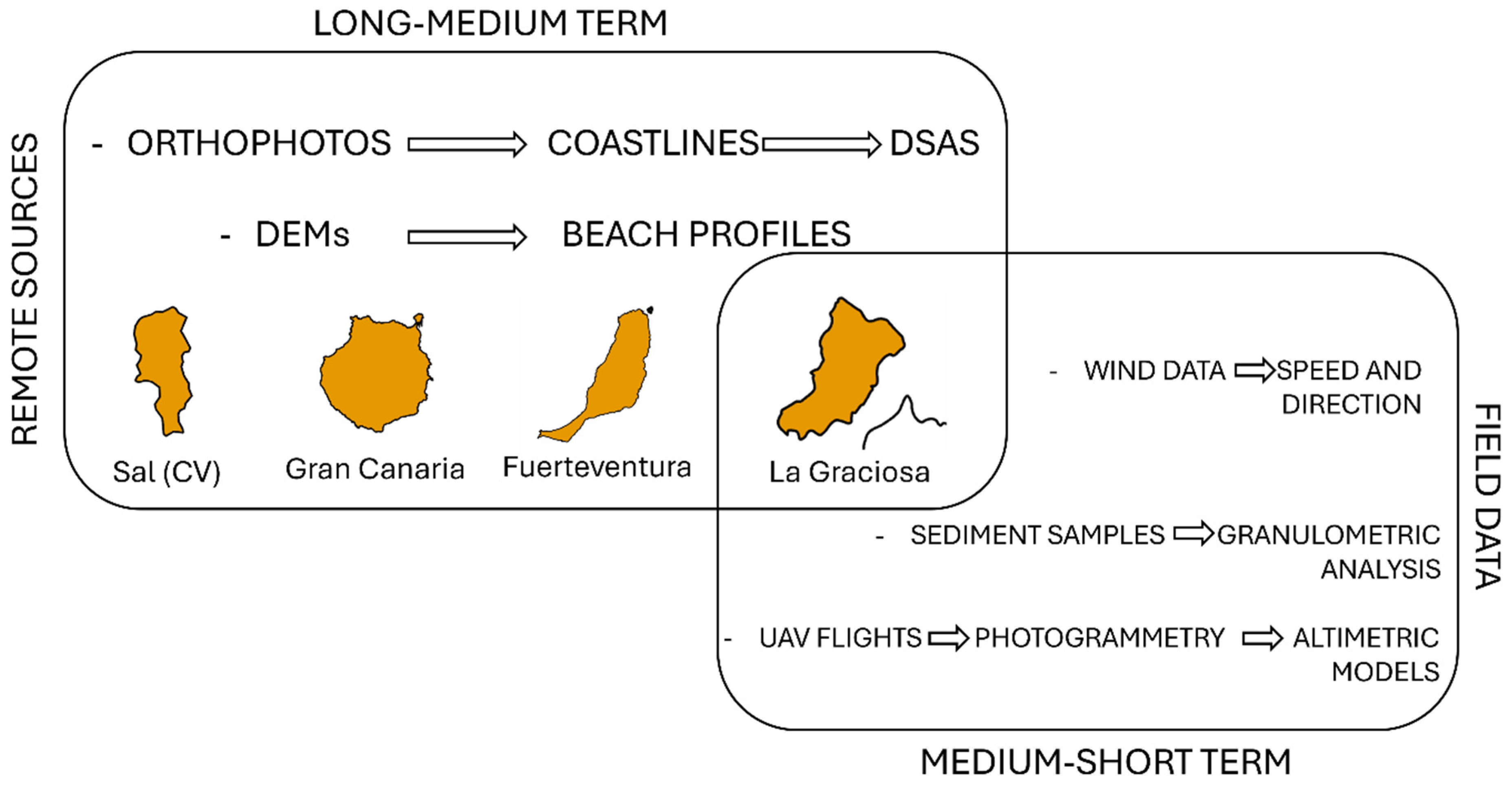

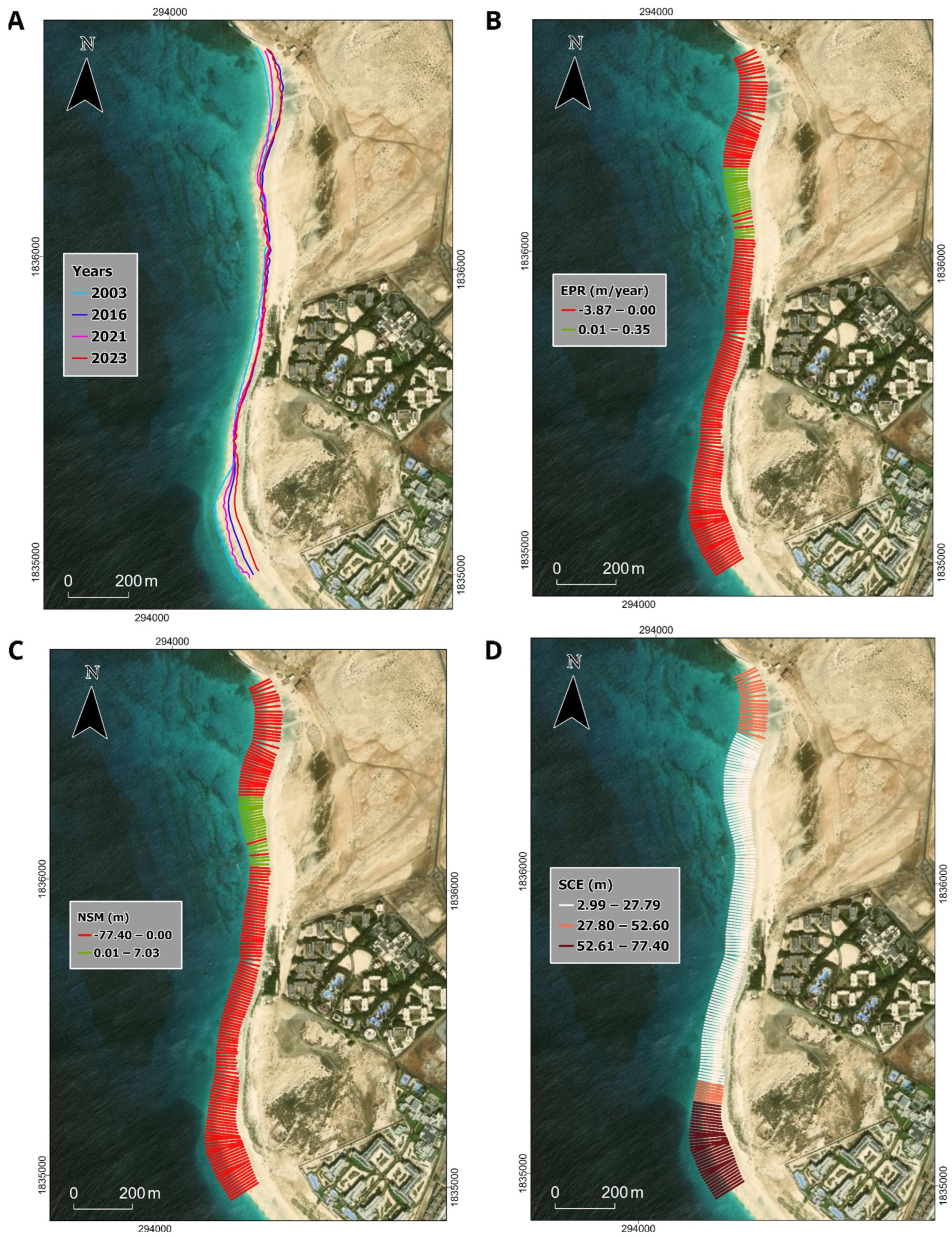


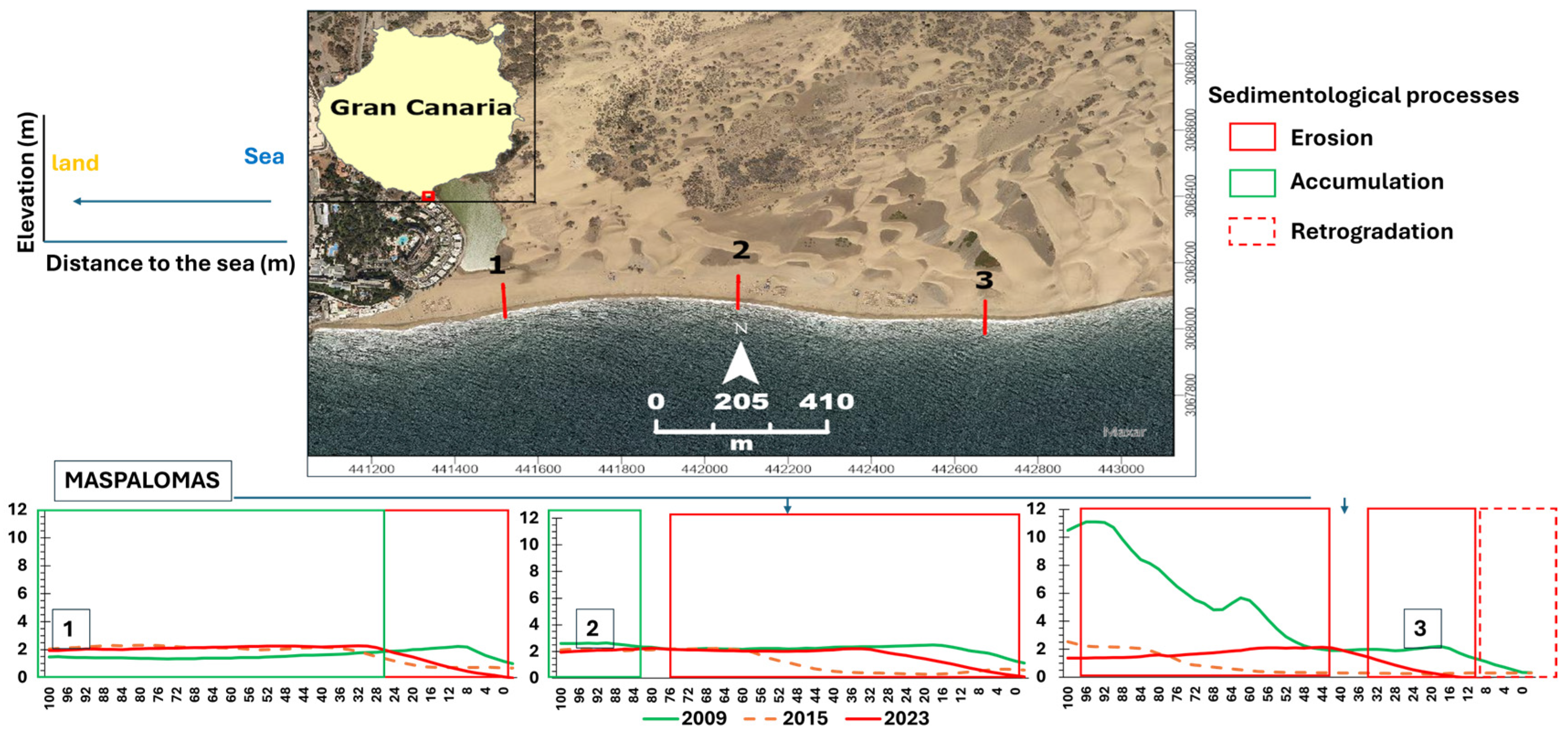

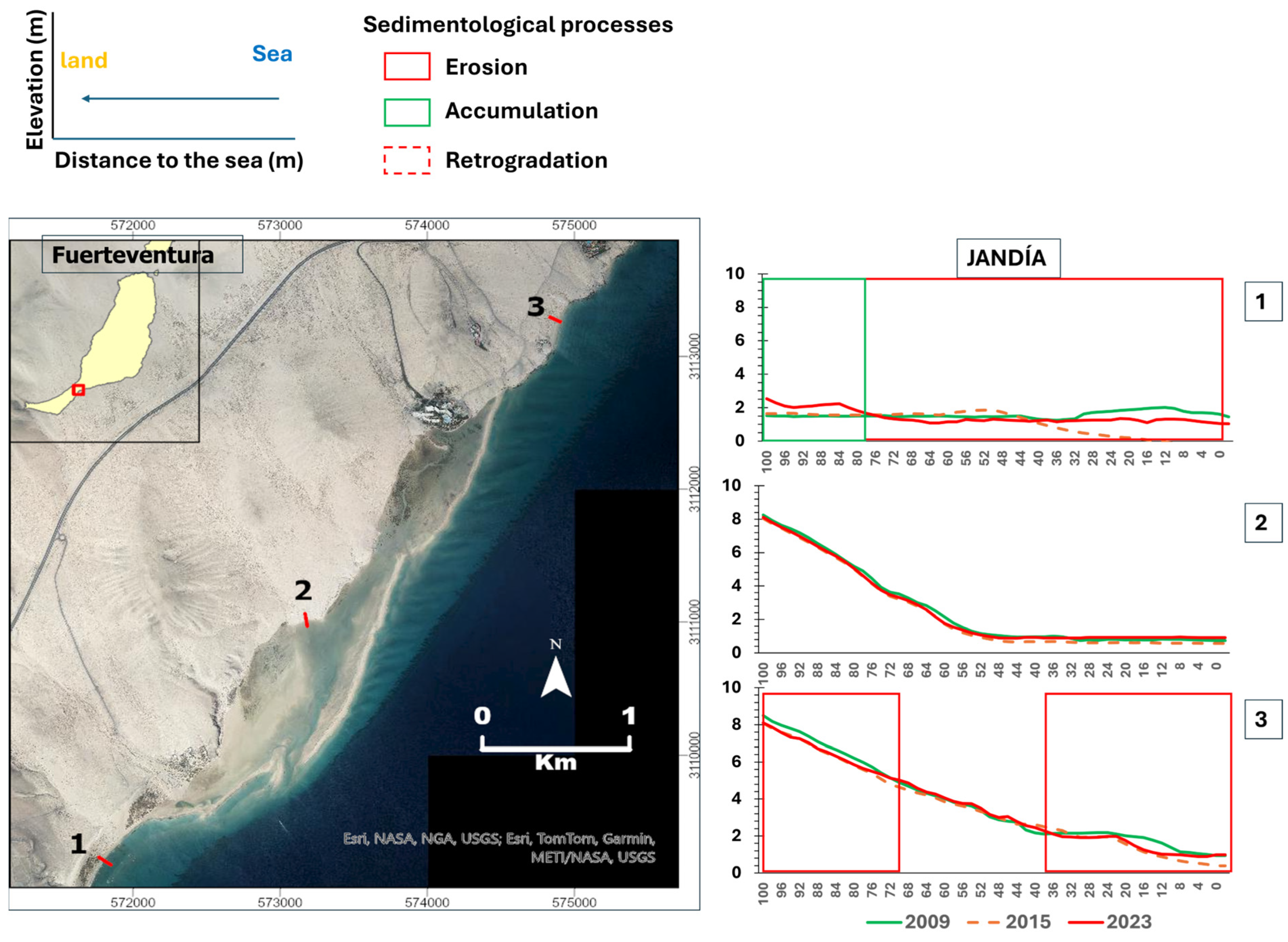
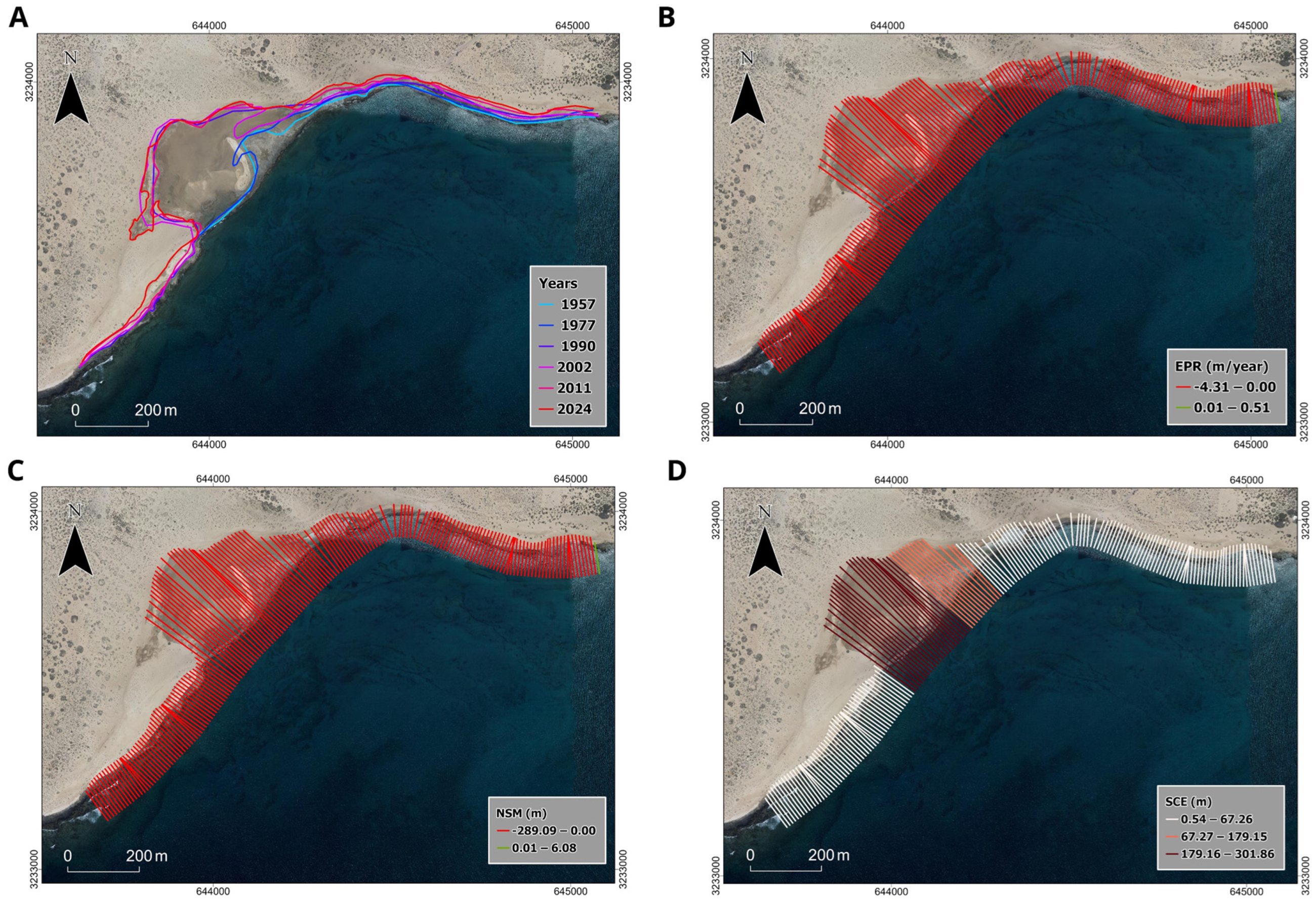
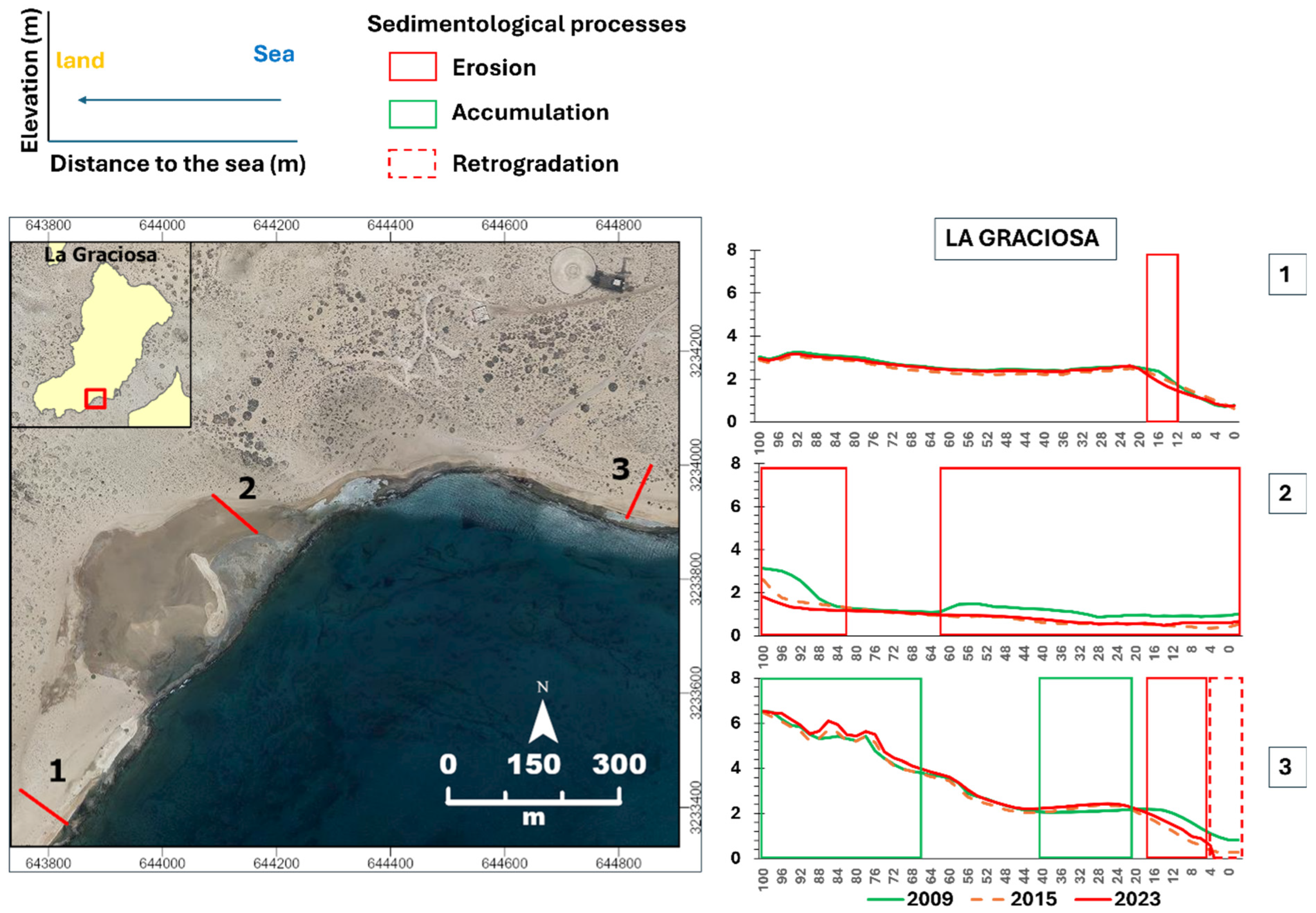
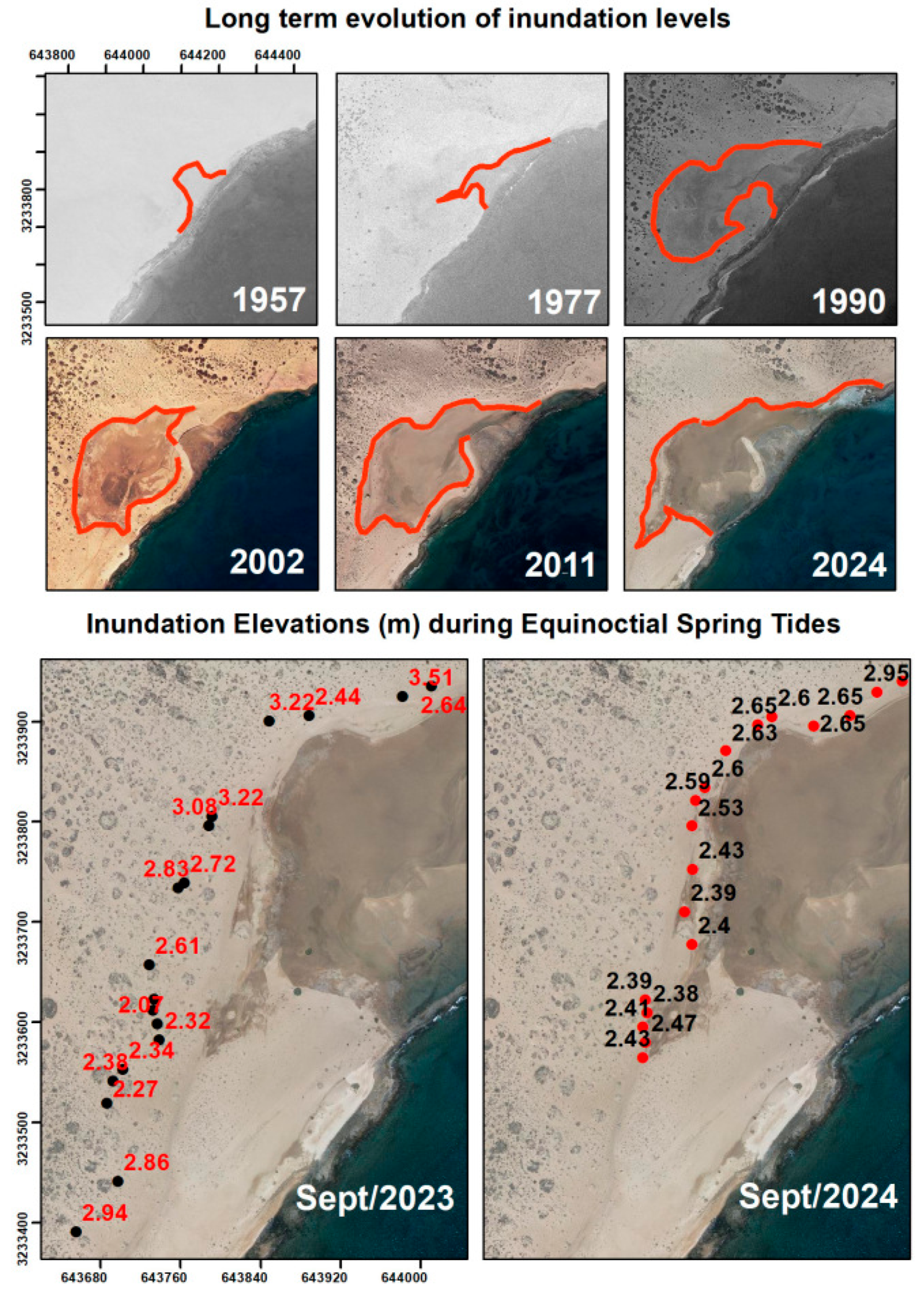

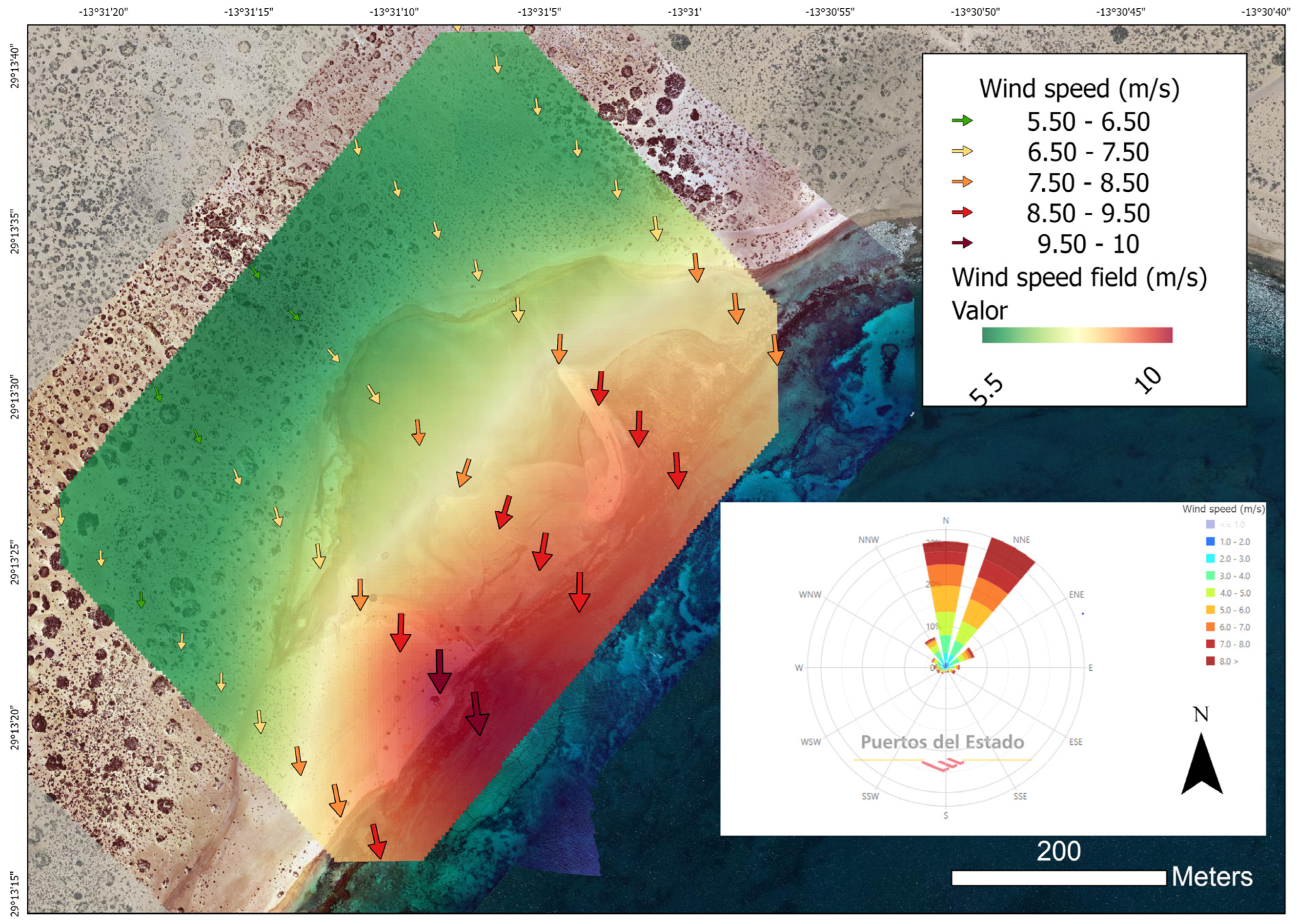
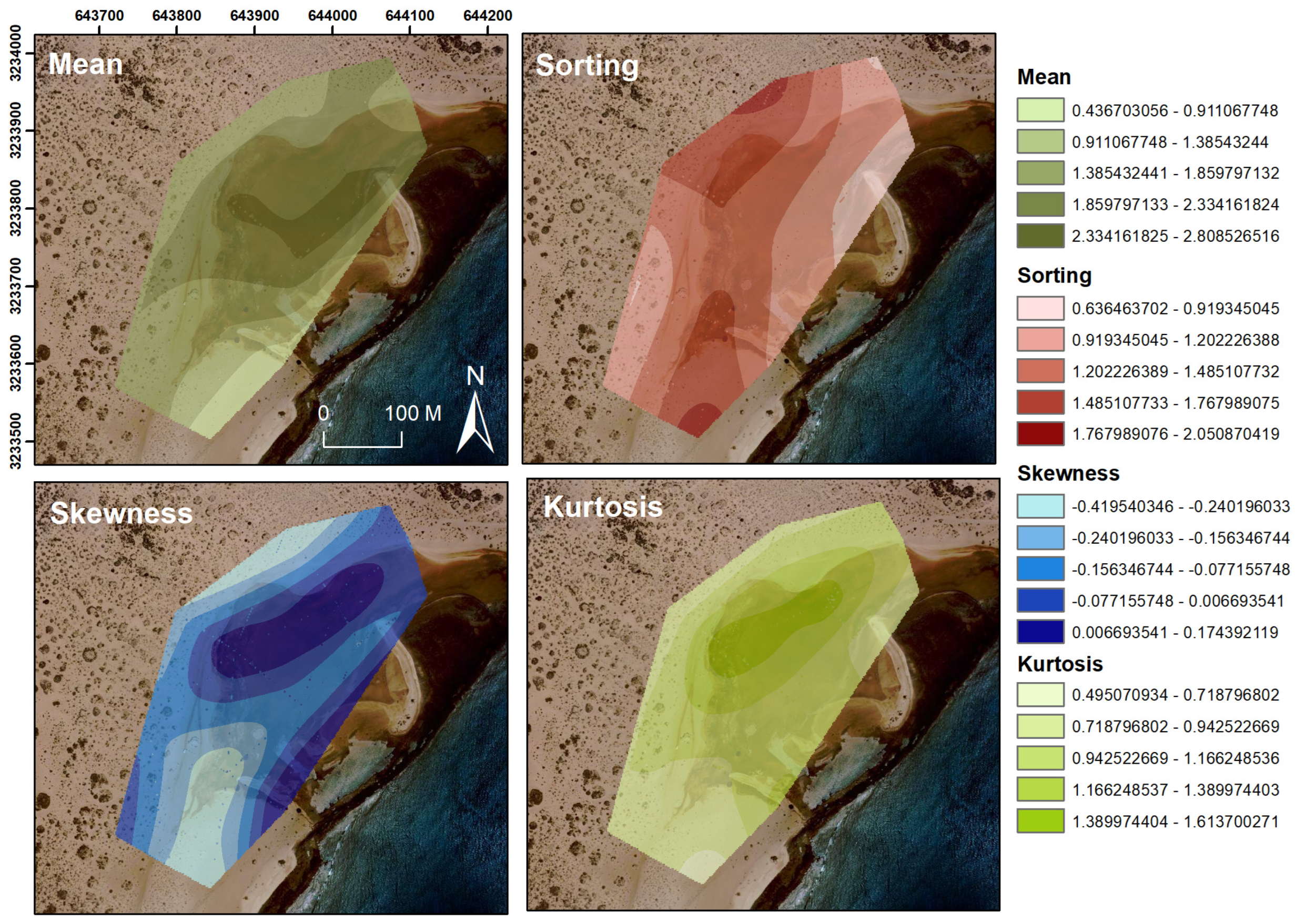
| Source Type | Study Area | Source | Time Series (Date) | Resolution (m) | RMS (m) |
|---|---|---|---|---|---|
| Historical aerial photographs/Orthophotos | Costa Fragata (Sal) | Google Earth | 2003, 2012, 2016, 2023 | 0.15–1.5 | - |
| Maspalomas (GC) | IGN and GRAFCAN | 1957, 1961, 1977, 1987,1998, 2009, 2019, 2024 | 0.12–1 | 0.12–1.3 | |
| Jandía (FV) | IGN and GRAFCAN | 1956, 1969, 1981, 1994, 2002, 2009, 2018, 2024 | 0.2–1 | 0.15–1.3 | |
| La Graciosa | GRAFCAN | 1957, 1977, 1990, 2002, 2011 and 2024 | 40–50 cm/pixel | <1.5 | |
| Digital Elevation Models (DEMs) | Costa Fragata (Sal) | - | - | - | - |
| Maspalomas (GC) | PNOA | 2009, 2015, 2023 | 0.5–5 points/m2 | <0.2 | |
| Jandía (FV) | PNOA | 2009, 2015, 2023 | 0.5–5 points/m2 | <0.2 | |
| La Graciosa | * PNOA, ** GRAFCAN | 2009 *, 2010 **, 2011 **, 2014 **, 2015 *, 2018 **, 2020 **, 2023 * | 0.5–5 points/m2 | <0.2 |
Disclaimer/Publisher’s Note: The statements, opinions and data contained in all publications are solely those of the individual author(s) and contributor(s) and not of MDPI and/or the editor(s). MDPI and/or the editor(s) disclaim responsibility for any injury to people or property resulting from any ideas, methods, instructions or products referred to in the content. |
© 2025 by the authors. Licensee MDPI, Basel, Switzerland. This article is an open access article distributed under the terms and conditions of the Creative Commons Attribution (CC BY) license (https://creativecommons.org/licenses/by/4.0/).
Share and Cite
Sanromualdo-Collado, A.; Marrero-Rodríguez, N.; Suárez-Pérez, C.A.; Sánchez-García, M.J.; Taxonera, A.; Hernández-Calvento, L.; García-Romero, L. Sediment-Deficit Sink-Zone Morphodynamics in Oceanic Island Dune Systems: Integration of Field Data and Remote Sources in the Macaronesian Region. Remote Sens. 2025, 17, 3731. https://doi.org/10.3390/rs17223731
Sanromualdo-Collado A, Marrero-Rodríguez N, Suárez-Pérez CA, Sánchez-García MJ, Taxonera A, Hernández-Calvento L, García-Romero L. Sediment-Deficit Sink-Zone Morphodynamics in Oceanic Island Dune Systems: Integration of Field Data and Remote Sources in the Macaronesian Region. Remote Sensing. 2025; 17(22):3731. https://doi.org/10.3390/rs17223731
Chicago/Turabian StyleSanromualdo-Collado, Abel, Néstor Marrero-Rodríguez, Carlos Avigdor Suárez-Pérez, María José Sánchez-García, Albert Taxonera, Luis Hernández-Calvento, and Leví García-Romero. 2025. "Sediment-Deficit Sink-Zone Morphodynamics in Oceanic Island Dune Systems: Integration of Field Data and Remote Sources in the Macaronesian Region" Remote Sensing 17, no. 22: 3731. https://doi.org/10.3390/rs17223731
APA StyleSanromualdo-Collado, A., Marrero-Rodríguez, N., Suárez-Pérez, C. A., Sánchez-García, M. J., Taxonera, A., Hernández-Calvento, L., & García-Romero, L. (2025). Sediment-Deficit Sink-Zone Morphodynamics in Oceanic Island Dune Systems: Integration of Field Data and Remote Sources in the Macaronesian Region. Remote Sensing, 17(22), 3731. https://doi.org/10.3390/rs17223731







